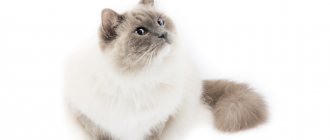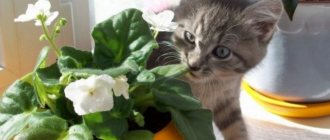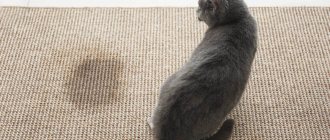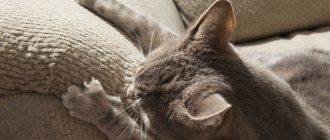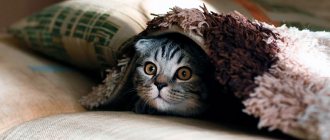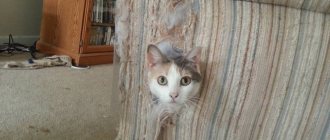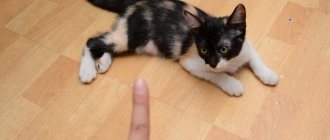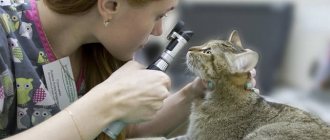How to stop a cat from eating indoor flowers? Why do cats show interest in flowerpots? These questions are often asked on forums by owners of furry pets or those who are just planning to get a kitten. Indeed, it is not entirely pleasant when a cat happily gnaws leaves and buds of indoor plants grown with great love, or even more so goes to the toilet in a flower pot.
Throwing a slipper at a pet, rude shouts, reproaches and even physical force do not always give a positive result.
Therefore, in order to wean a cat from this harmful habit, you need not only to approach the training process responsibly and with great patience, but also to understand why your beloved pet shows interest in flower pots and gnaws on house plants.
Why do cats eat plants and greens?
Our pets are typical carnivores whose diet is based on meat and offal. Wild forest cats - the closest relatives of our Murkas - eat rodents, lizards, and small birds. Since both wool and bones are used as food, a certain amount of undigested residues gradually accumulates in the digestive tract. In order to cleanse the intestines of them, animals require plant food - grass and wild plants. Cats living in a city apartment do not have the opportunity to eat grass, so they find a way out by eating indoor plants.
Another reason why cats cannot do without fresh greens is hairballs in the stomach. No matter how carefully you care for the animal’s fur, your pet will still lick it and, willy-nilly, swallow a few hairs. Plants are also needed to remove indigestible lumps. To come to terms with your pet's raids on flower pots, you need to accept the fact that cats' craving for plants is not a whim, but an instinct. Grass and greens, enthusiastically eaten by our pets, not only help cleanse the stomach and intestines, but also normalize the digestion process, help cope with constipation, provide animals with vitamins and minerals, and in case of poisoning, help neutralize toxins.
Our pets show exceptional selectivity in taste preferences. If your neighbor complains that her cat is nibbling on the young shoots of pelargonium, do not rush to hide these plants from your cat: it may turn out that she prefers freshly fallen hibiscus flowers or fluffy (what is not a mouse?!) Saintpaulia leaves. Some plants with long, narrow grass-like leaves - chlorophytum, dracaena, nolina, various types of narrow-leaved palms - are very popular with all cats without exception.
Liana-like plants - tradescantia, cissus, hoya, ivy-leaved pelargonium - with long shoots hanging down, young and overly active animals are an excellent toy. Even ficus rubber plants, which seem completely unattractive to cats, can become victims of our pets - some cats relieve stress by jumping onto the top of these plants, bending them to the floor, and then letting go. The methodical repetition of these actions calms the animals, but the ficus has a hard time: its trunk little by little becomes like a drawn bow.
Does your pet dig the soil in flowerpots and regularly eat leaves? Be sure to show him to the vet! The reason for this may be not only banal boredom, but also:
- lack of certain vitamins;
- disruption of metabolic processes in the body;
- helminthic infestation;
- constant constipation;
- digestive problems;
- poisoning.
If your pet not only gnaws the leaves of plants, but also digs up the soil in a flowerpot or goes to the toilet there, think about whether you are giving him enough time? Do you play with him? Do you allow me to purr freely on your lap? Such behavior most often indicates an attention deficit. There is another reason why the cat behaves this way. He may not like the place where the tray is located, or he may not be satisfied with the quality of the filler. An animal that has spent most of its life on the street may not appreciate the tray itself: in the ground, and besides, under a “tree”, it is much more familiar to it.
Other reasons
One of the reasons cats chew or pull flowers out of pots is obsessive-compulsive disorder. Does your pet, when stressed, chew on a blanket or a stuffed bunny's ear, a rag, or your fancy dress? This is a clear sign of obsessive-compulsive neurosis. Most often, such a disorder occurs in Abyssinians, Burmese or Siamese, and less often in exotics. It is very difficult to cope with it on your own, and in some cases it is even impossible, so the best thing you can do in this case is to seek help from a qualified animal psychologist.
Your cat eats what can only be conditionally called edible, giving preference to:
- newspapers;
- wallpaper;
- plaster;
- electrical cords;
- jute twine
With a high degree of probability, we can assume that your pet has pararexia - a perversion of taste. The cause of this phenomenon can be genetic predisposition, severe stress, emotional stress, and congenital anomalies. We should not forget that an animal’s pathological addiction to inedible objects can pose a serious danger to its health and even lead to truly tragic consequences. Poisoning, intoxication, blockage of the intestinal lumen and damage to the mucous membrane of the digestive tract, which can be caused by blockage of the intestinal lumen by foreign objects, are a common result of such a disorder. Therefore, if your pet has an unhealthy addiction to houseplants that is not associated with hypovitaminosis or constipation, the best thing you can do is leave two or three flowers in the house that do not pose a danger to the animal, or get rid of all plants.
Why you need to stop your cat from eating indoor flowers
For people who have little knowledge of indoor floriculture, the question of why it is necessary to wean a cat from eating flowers is perplexing. Wean? For what? Let him gnaw, what's wrong with that?
In fact, weaning a cat from eating indoor flowers is the number one task for a caring and responsible owner. Most of the plants that decorate our windowsills are poisonous to one degree or another - and not just to cats. Even such familiar plants as asparagus, spathiphyllum, callas, all types of ficus and pelargonium, not to mention amaryllis, hippeastrum and ivy, pose a great danger, careless handling of which can lead to severe poisoning not only of the cat, but also of the owner himself. . The beauty and pride of our gardens and loggias - hydrangeas - can provoke an attack of acute intestinal upset, abdominal pain, nausea and vomiting. A wonderful garden and balcony plant - hellebore - leads to heart rhythm disturbances. Even everyone’s favorite bulbs (tulips, daffodils, hyacinths, muscari), which we put out for forcing for the New Year and spring holidays, should be kept as far as possible from our pets: their pollen can cause an allergic reaction in them.
Many exotic plants that can be found in our homes are deadly to cats. The substances they contain can cause severe intoxication, depression of the respiratory center, heart and blood vessels, muscle spasms, paralysis and anaphylactic shock. The juice of many varieties of ficus leads to burns of the mucous membranes (as a result of this, not only the animal’s oral cavity suffers, but also the larynx, esophagus, stomach), and affects the liver and kidneys.
No less dangerous than the plants themselves are flower care products. Treatment of plants with acaricidal preparations and foliar feeding should be carried out out of the reach of pets.
Young kittens need to be monitored especially closely. Trying to taste a poisonous plant can end very badly.
If you keep a cat and at the same time plan to take up indoor or garden floriculture, be sure to ask an experienced veterinarian which plants are safe for your pet and which ones should be discarded immediately.
Vitamin deficiency
Animals with free access to the outdoors can easily replenish the balance of essential nutrients with the help of various herbs. The pet's diet is mainly limited to dry food. The bad habit of encroaching on indoor flowers manifests itself in the autumn-spring period, when the lack of important vitamins and microelements is especially acute. Cats may eat green plants in hopes of getting missing nutrients.
What to do if a cat spoils house plants
It is necessary to teach an animal good manners from the first day of being in the house. He must learn once and for all what he can do and what he cannot do. In this case, you need to act calmly, in no case using shouts, abuse, or, even worse, physical force. You don’t want to aggravate the situation and achieve a result that is exactly the opposite of what you want? Believe me, the cat understands everything perfectly! And the fact that he is committing a serious crime, and that he will be punished one way or another, and whether you are angry with him or very upset. Feeling your anger, he will take revenge. Seeing your tears, he will honestly try to spare your feelings and commit his outrages only when you are not at home. It’s impossible to dream of a cat voluntarily giving up raiding windowsills, so all you can do is educate him.
Cats are not dogs. Since punishments and prohibitions do not work on them, compromise or try to outsmart them. If cats gnaw or pull flowers out of a pot, try to make them lose the slightest attractiveness to domestic predators: for example, thickly spray the flowerpots and the plants themselves with a solution of pharmaceutical tincture of capsicum, garlic infusion or lemon juice. The flowers will become disgustingly bitter and completely inedible, causing cats to lose all interest in them. Plants treated in this way will be able to restore their thinning crown and will be transformed before our eyes - after all, by scaring away cats, you have also rid them of pests! - and they will thank you with unprecedented flowering.
If treatment with natural remedies does not bring a noticeable result, you can use drugs to wean cats from going to the toilet in the wrong place.
Did this remedy also not bring the desired effect? Let's think about what else we can do.
Curiosity and Attention
Life in a closed space with constantly busy owners is boring and monotonous. A sedentary lifestyle involuntarily forces the cat to look for entertainment among what is found within its reach. Hanging flat leaves, swaying at the slightest movement, arouse great interest. In the rush of a gaming mood, it’s difficult to resist tasting the plant. If your cat lacks your attention, he can attract it in the following ways:
- there are flowers;
- relieve yourself if the size of the pot allows;
- dig up the ground;
- throw pots on the floor.
Wean the cat from eating flowers
To wean a cat from climbing into a flower pot, you need to show resourcefulness and considerable ingenuity. If your cat eats plants not because of a vitamin deficiency or because of a worm infection (both problems can be solved fairly quickly and easily with the help of appropriate medications), you will have to be patient and prepare for a long struggle.
Before you begin to take decisive action, you need to find out exactly what caused such deviation in behavior. Be sure to show your pet to the veterinarian. In any case, consultation with an experienced specialist will not be superfluous. You will make sure that there are no physiological reasons for the cat to have indoor plants, and with peace of mind you can begin to re-educate your pet.
To wean a cat from eating flowers in pots, it is enough to abandon any educational measures. Does your cat want to munch on some fresh greens? Let him eat for his health, but not the specimens from the indoor greenhouse, but special grass. You can buy it at any pet store - both seeds and already sprouted. One could object to this by saying that if a cat needs grass so much, why not pick it up on the nearest lawn? Unfortunately, such vegetation cannot be considered completely safe, and it is accessible only in the warm season.
To stop your pet from encroaching on potted flowers, place them where he cannot reach them. If the flowerpots are placed on the windowsills, even the most indifferent cat to flowers will come up with the idea of biting off a leaf - if only to test your reaction. Walk around the apartment and pay attention to those places where the mustachioed predator has never climbed: high cabinets, shelves on the walls, located at some distance from sofas and bedside tables. If these places are sufficiently well lit by the sun's rays or phytolamps can be placed above them, do this immediately. A collection of Saintpaulias or other small plants can be put on a wick and placed on a shelf closed on all sides - the spectacle is fantastically beautiful, care is minimal, and the cat certainly won’t get to them. For phalaenopsis, you can build a spacious orchidarium, or put low cacti in a greenhouse with lighting. The best place for hanging plants is hanging flowerpots. Plants with long shoots look especially advantageous in them, and the cat will only have to walk under them, raising his whiskers up, and wait for an opportunity to attack.
If your pet has chosen a spacious flowerpot with a date palm or other large plant as a night vase, decorate the surface of the soil in the flowerpot with sea pebbles and shells - small and, if possible, prickly. The composition will immediately take on a finished look, and the cat, trying to dig a hole in the usual place, will be unpleasantly surprised: the uncomfortable surface and the distinct knocking sound made by the objects being turned over are not at all conducive to relaxation. If the shells do not fit into your interior at all, you can stick toothpicks or matches cleared of sulfur into the soil - not so that the cat will prick itself, but only to feel some discomfort.
A good option would be to treat plant leaves with some odorous mixture that is harmless to the animal, but quite effective. It can be the aroma of perfume, lemon, onion, spices, essential oil. It is important to choose a remedy that would not cause allergies in the cat - only disgust. Some animals run away from any smell other than the aroma of food, others sniff onions with great pleasure and are calm about citrus fruits. You can spray the flowers in your house with an infusion of orange peels, and also sprinkle the soil in flowerpots thickly with dry peels, but unfortunately, there is no guarantee that the cat won’t scoop them all out with a couple of strokes and demonstratively spit them into the flowerpot.
Do you only have a window at your disposal? Is it possible and, if indeed it is possible, then how to wean a cat from climbing on the windowsill? You will have to take tough and even cruel measures: cover it with double-sided tape or at least wrap it with regular tape. It looks extremely unaesthetic, but plants nibbled by a cat decorate the interior even less, so you have to choose the lesser of two evils. Having stepped on the sticky surface, the cat will jump to the floor in horror and after two or three attempts will forever swear off approaching the flowers.
An unbalanced diet, lack of attention, constant stress, mental disorders - all these factors affect the behavior of our pets. Try to eliminate them or minimize their impact. Most often, this is enough to stop the cat from eating flowers forever.
Do no harm
Very often, a domestic predator simply simply does not have enough greenery. You need to buy a special mixture for planting grass, which sprouts very quickly. All cats eat such green shoots with pleasure. The pot with this special herb should be placed in the place where the most gnawed flower stands. When the cat becomes a little cooler towards flowers, it is better to move her grass away from valuable plants. Over time, the predator will have a path only to his personal lawn. But you need to keep an eye on this cat grass to make sure it is always available. Otherwise, attacks on flowers will resume again.
Special grass for cats
Swearing loudly with a cat or poking your nose at damaged flowers is very ineffective. It is only for the housewife that these plants on the window are valuable. For a cat, flowers are divided only into those that are convenient for nibbling or those that are inconvenient.
But how can you stop a cat from gnawing flowers if the cat’s grass is not to his taste? Then the process may be delayed. Some resources advise spraying the leaves with solutions with unpleasant odors for clawed predators. For example, citrus fruits. But this will not help much, sometimes it will even harm the plants more than a toothy cat.
My own experience has confirmed this. I sprayed a weak solution of citrus oil on the money tree that the kittens were dealing with. As a result, after 3 days, the tearing of leaves continued. And a week later, the money tree dropped almost all its leaves. The use of aerosols can lead to the complete death of the plant.
Gimpet Katzen Grass Fast-germinating grass for cats, 100 g
Price: 131 rub. 177 rub. 26% discount for you!
Cleanses the gastrointestinal tract and prevents constipation. Fast delivery throughout Russia. And also more than 3,000 other pet products at competitive prices! Take a look!
Reviews
Dear readers, was this article helpful? Have you ever encountered a situation where you had to stop your cat from chewing flowers? Leave feedback in the comments! Your opinion is important to us, and it will be useful to other people who also have their pets chewing flowers!
Veniamin, Krasnodar
“Our cat often raided pots of geraniums, and my wife and I treated this as a necessary evil. Once, my wife sprayed flowers against pests with water infused with dry lemon peels. The cat came up, sniffed and darted out of the room. I didn’t approach them for a long time. Then the effect of the infusion apparently weakened, and he began to act evil again. But we were already on our guard. There was no need for a third time: the cat doesn’t come near the flowers anymore.”
Diana, Alushta
“I taught my Marfusha not to bite flowers using double-sided tape. We live in a microscopic one-room apartment, one window - onto the balcony, but my soul wants flowers! Anyone who has fifty violets will probably not even notice that there is one less. And I only have three of them! And the cat began to eat these unfortunate violets little by little. Once I found a leaf on the floor, twice... I decided that it had fallen off on its own. Then the cat realized that she could do anything, and climbed onto the windowsill right in front of my eyes. “Like you, so am I!” – I thought and immediately demonstratively covered the entire window sill with double-sided tape. The cat carefully watched my actions, not understanding what awaited her. When I went to wash my hands, I heard her wild howl. She stomped on the windowsill, unable to unhook herself, and screamed in horror. One time was enough for her not to even come close to the window.”
